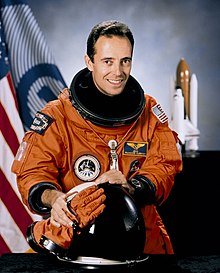|
Jean-François Clervoy
Jean-François André Clervoy (French pronunciation: [ʒɑ̃ fʁɑ̃swa ɑ̃dʁe klɛʁvwa]; born 19 November 1958) is a French engineer and a CNES and ESA astronaut. He is a veteran of three NASA Space Shuttle missions. Early life and educationClervoy was born 19 November 1958 in Longeville-lès-Metz, France, the son of Mireille Lemonde and Jean Clervoy, a former French Air Force pilot.[1] From an early age, he took an interest in space exploration and dreamt of becoming an astronaut:
While born in the French region of Lorraine, Clervoy considers Toulouse to be his adopted hometown.[3] He has a twin brother, Patrick Clervoy, a military psychiatrist. He received his baccalauréat from Collège Militaire de Saint-Cyr-l'École in 1976; he passed Math. Sup. and Math. Spé. M' at Prytanée Militaire, La Flèche in 1978. He graduated from École Polytechnique, Paris, in 1981. He then became a member of the Corps of Armament. He graduated from École nationale supérieure de l'aéronautique et de l'espace, Toulouse, in 1983; he graduated as a Flight Test Engineer from École du personnel navigant d'essais et de réception, Istres, in 1987. Experience
In 1983 Clervoy was seconded from the Direction générale de l'armement (DGA) to CNES (French Space Agency) where he works on autopilot systems for various projects such as the earth observation satellite SPOT, the optical inter-satellite space link STAR, or the comet probe VEGA. Clervoy is Ingénieur Général de l'Armement in the Corps of Armament at the DGA. He was selected in the second group of French astronauts in 1985 and started intensive Russian language training. From 1987 until 1992 he directed the parabolic flight program at the Flight Test Center, Brétigny-sur-Orge and provided technical support to the European human space program within the ESA Hermes crew office in Toulouse. From 1983 to 1987, Clervoy was also a lecturer in signal processing and general mechanics at the École nationale supérieure de l'aéronautique et de l'espace, Toulouse. In 1991, he trained in Star City, Moscow, on the Soyuz and Mir systems. In 1992, he joined the Astronaut Corps of the European Space Agency (ESA) at the European Astronaut Center EAC in Cologne. In August 1992 Clervoy was detached to the NASA Johnson Space Center/ Houston to gain the Space Shuttle mission specialist qualifications. In between his space flights, Clervoy was assigned as flight software verification lead in the Shuttle Avionics Integration Laboratory (SAIL) and as robotics display design lead for Shuttle and ISS. After his third spaceflight, he was assigned as the International Space Station display integration lead in the NASA-JSC Astronaut Office. He flew twice aboard Space Shuttle Atlantis and once aboard Discovery or a total of 675 hours in space. Due to the difficulty that American astronauts had in pronouncing his name, Clervoy was nicknamed "Billy Bob." From 2001 through 2008, he was assigned Senior Advisor Astronaut of the Automated Transfer Vehicle ESA project in Les Mureaux (France). In 2008, he was also appointed member of the selection board for the new ESA astronaut class. Clervoy holds military and civilian parachuting licenses, military and civilian scuba-diving licenses, and private pilot license. Spaceflight experience
Current assignmentClervoy is a member of ESA’s European Astronaut Corps, based at the European Astronaut Centre in Cologne, Germany. As part of his ESA collateral duties, Clervoy provides support to the human spaceflight programme, the external relations department and the sustainable development office. He is also Chairman and strategy manager of Novespace, a subsidiary of French space agency CNES in charge of the parabolic flight programme based on the A310 Zero-G aircraft in Bordeaux-Mérignac, France. Personal lifeHe is married to Laurence Boulanger and they have two children. Clervoy enjoys racquet sports, skill games, canyoning, skiing, and flying activities such as boomerang, frisbee, kites. OrganisationsMember, Association of Space Explorers (ASE). Distinguished member, French Aeronautics and Astronautics Association (3AF). Member, Air and Space Academy (ANAE). Member, International Academy of Astronautics (IAA). Member, American Institute of Aeronautics and Astronautics (AIAA). Ambassador of the World Ocean Network. Patron of the marine life preservation non-profit association 'Te mana o te moana' in French Polynesia. JF Clervoy is also the ESA representative for the ocean exploration ‘SeaOrbiter’ project. Special honours
Tributes
PublicationsJean-François Clervoy is the author of the book "Histoire(s) d'Espace" relating his third mission towards the Hubble space telescope. He is also the co-author of the works: "Voler en apesanteur" and "Embarquer dès demain pour l'espace" (Ed. Vuibert), "Dans les bars des bouts du monde" and "La Diva, le Président et autres face-à-face" (Ed. L'Elocoquent), "Vox confidential" (Ed. Michel Lafon), "Histoire de la conquête spatiale" (Ed. Vuibert). PatentJean-François filed an international patent for the functions of the wrist watch ‘Speedmaster Skywalker X-33’ produced by Omega, tested and qualified by ESA. References
External linksWikimedia Commons has media related to Jean-François Clervoy. |
||||||||||||||||||||||||||||||
Portal di Ensiklopedia Dunia

